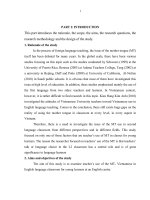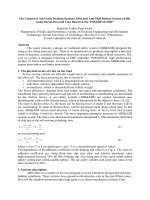Antilock braking system (ABS)
Bạn đang xem bản rút gọn của tài liệu. Xem và tải ngay bản đầy đủ của tài liệu tại đây (641.28 KB, 15 trang )
Anti-lock braking system
Anti-lock braking system
(ABS)
I. Preamble.
To elevate English language capability for automotive
engineering, and survey is extra about knowledge related
to automobile,we are students in DHOT2 class,in Ho Chi
Minh university of industry. We introduce to Teacher
and every peoples about our essay, with topic : Anti-lock
braking system.
Although, we tried to perfect our esay but our knowledge
are finite. So we do not escape faults, hope Teacher help.
Technical English for automotive engineering.
1
Anti-lock braking system
II. Contents.
1. Introduction.
Anti-block braking system is a system on motor vehicles which
prevents the wheels from locking while braking. An anti-locking
braking system allows the driver to maintain steering control under
heavy braking by preventing a skid and allowing the wheel to continue
to forward roll and create lateral control, as directed by driver steering
inputs. Most commonly, braking distances are shortened.
Disadvantages of the system include increased braking distances under
rather rare circumstances and the creation of a "false sense of security"
among drivers who do not understand the operation and limitations of
ABS.
Since it came into widespread use in production cars, ABS has made
considerable progress. Recent versions not only handle the ABS
function itself (i.e. preventing wheel locking) but also traction control,
brake assist, and electronic stability control, amongst others.
Anti-lock braking systems were first developed for aircraft in 1929 by
the French automobile and aircraft pioneer Gabriel Voisin, as threshold
braking an airplane is nearly impossible.
Anti-Lock Brake Types:
Four-channel, four-sensor ABS, Three-channel, three-sensor ABS,
Two-channel, two -sensor ABS, One-channel, one-sensor ABS.
Technical English for automotive engineering.
2
Anti-lock braking system
2. Constitution of anti-lock braking system
The Antilock Braking System (ABS) consists of a conventional
hydraulic brake system plus antilock components.
a. draulic unit
The hydraulic unit with the attached EBCM is located between the
surge tank and the fire wall on the right side of the vehicle. The basic
hydraulic unit configuration consists of return pump motor, return
pump, four isolation valves, four dump valves, two Low Pressure
Accumulators (LPA), two High Pressure Attenuators (HPA).
The hydraulic unit controls hydraulic pressure to thefront calipers and
rear wheel cylinders by modulating
hydraulicpressure to prevent wheel
lockup.
b. antilock components.
Antilock components include an
electronic brake control module
(EBCM), two system fuses,four wheel
Technical English for automotive engineering.
3
Anti-lock braking system
speed sensors (one at each wheel), interconnecting wiring, the ABS
indicator, and the rear drum brake…
Isolation valve
Dump Valve
Technical English for automotive engineering.
4
Anti-lock braking system
Low pressure accumulator
High Pressure Attenuator
Technical English for automotive engineering.
5
Anti-lock braking system
Return Pump Motor
3. Operating principle.
Compression stroke: the pump is filled via the inlet ball seat, then the
motor eccentric rotates moving the piston to displace the fluid. After
the pressure build-up closes the inlet valve the piston displacement
increases the pressure until the outlet ball opens. The outlet
pressurewill continue to increase for the rest of the piston stroke.
Return Stroke: The piston retracts, forced by its spring, as the motor
eccentric returns to its low end position.
The pressure at the inlet side of the outlet ball then decreases due to
the displaced volume and the pressure difference across this ball holds
it closed.The pressure at the outlet side of the inlet ball seat,which is
Technical English for automotive engineering.
6
Anti-lock braking system
set to open at a certain pressure level also decreases until this valve
opens. With the outlet ball closed, the pump is filled with additional
fluid from the low pressure accumulator.
The pressure will continue until a stall point is reached and
compression of the piston cannot generate enough differential
pressure anymore to open the outlet ball seat.
The ABS equipment may also be used to implement traction control
on acceleration of the vehicle. If, when accelerating, the tire loses
traction with the ground, the ABS controller can detect the situation
and take suitable action so that traction is regained. Manufacturers
often offer this as a separately priced option even hough the
Technical English for automotive engineering.
7
Anti-lock braking system
infrastructure is largely shared with ABS. More sophisticated versions
of this can also control throttle levels and brakes simultaneously.
4. wheel speed sensors and rings.
Front wheel speed sensors are installed to the front
knuckle and rear wheel speed sensors are installed to
the backing plate.
Wheel speed sensors are no
serviceable. And the air
cap is not adjusted. Front
wheel speed sensor ring is
pressed onto the drive axle
shaft. Each ring contains 40
equally spaced teeth.
Exercise care during
service procedures
to avoid prying or
contacting this ring.
Excessive
contact may cause damage
to one or more teeth.
Rear wheel speed sensor
rings are incorporated into
the HUB drum.
III. Discussion.
1.sign and selection of components.
Given the required reliability it is illustrative to see the choices made
in the design of the ABS system. Proper functioning of the ABS
system is considered of the utmost importance, for safeguarding both
the passengers and people outside of the car. The system is therefore
Technical English for automotive engineering.
8
Anti-lock braking system
built with some redundancy, and is designed to monitor its own
working and report failures. The entire ABS system is considered to
be a hard real-time system, while the subsystem that controls the self
diagnosis is considered soft real-time. As stated above, the general
working of the ABS system consists of an electronic unit, also known
as ECU (electronic control unit), which collects data from the sensors
and drives the hydraulic control unit, or HCU, mainly consisting of
the valves that regulate the braking pressure for the wheels.
The sensors measure the position of the tires, and are generally
placed on the wheel-axis. The sensor should be robust and
maintenance free, not to endanger its proper working, for example an
inductive sensor. These position measurements are then processed by
the ECU to calculate the wheel-spin.The hydraulic control unit is
generally located right next to the ECU (or the other way around), and
consists of a number of valves that control the pressure in the braking
circuits. All these valves are placed closely together and packed in a
solid block. This makes for a very simple layout, and is thus very
robust.
The central control unit generally consists of two microcontrollers,
both active simultaneously, to add some redundancy to the system.
These two microcontrollers interact, and check each other's proper
working. These microcontrollers are also chosen to be power-
efficient, to avoid heating of the controller which would reduce
durability. The software that runs in the ECU has a number of
functions. Most notably, the algorithms that drive the HCU as a
function of the inputs, or control the brakes depending on the recorded
wheel spin. This is the obvious main task of the entire ABS-system.
Apart from this, the software also needs to process the incoming
information, e.g. the signals from the sensors. There is also some
software that constantly tests each component of the ABS system for
its proper working. Some software for interfacing with an external
source to run a complete diagnosis is also added. As mentioned before
the ABS system is considered hard real-time. The control algorithms,
Technical English for automotive engineering.
9
Anti-lock braking system
and the signal processing software, certainly fall in this category, and
get a higher priority than the diagnosis and the testing software. The
requirement for the system to be hard real-time can therefore be
reduced to stating that the software should be hard real-time. The
required calculations to drive the HCU have to be done in time.
Choosing a microcontroller that can operate fast enough is therefore
the key, preferably with a large margin. The system is then limited by
the dynamic ability of the valves and the communication, the latter
being noticeably faster. The control system is thus comfortably fast
enough, and is limited by the valves.
2. How does ABS work?
ABS uses wheel speed sensors to determine if one or more wheels
are trying to lock up during braking. If a wheel tries to lock up, a
series of hydraulic valves limit or reduce the braking on that wheel.
This prevents skidding and allows you to maintain steering control.
3. Why do we want or need this.
In a recent Canadian Automobile Association survey of some 1700
members, 66% correctly associated ABS with vehicle stability in an
emergency, and 53% correctly stated that ABS allows the driver to
steer while braking.Since the ABS will not allow the tire to stop
rotating, you can brake and steer at the same time. The braking and
steering ability of the vehicle is limited by the amount of traction the
tire can generate.
If you demand steering while braking, the 100% of traction that the
tire can generate will be divided between both tasks. For example, if
you require 50% for steering then there is 50% of available traction
left for braking. If you require 10% for steering then there is 90% left
for braking. Be aware that 100% traction on a dry road is a great deal
more traction than 100% traction on ice! Therefore, your vehicle is
Technical English for automotive engineering.
10
Anti-lock braking system
unable to steer and brake as well on a slippery surface as it can on a
dry road.
4.Which vehicles have antilock braking systems,
and which ones don’t ?
The Department of Transportation requires that ABS be on: Air-
braked truck tractors built on or after March 1, 1997. Other air-braked
vehicles (trucks, buses, trailers and converter dollies) built on or after
March 1, 1998. Hydraulically-braked trucks and buses with a gross
vehicle weight rating of 10,000 lbs. or more built on or after March 1,
1999. Many commercial vehicles built before these dates have been
voluntarily equipped with ABS.
IV. Conclusion.
A 2003 Australian study
[1]
by Monash University Accident Research
Centre found that ABS:
Reduced the risk of multiple vehicle crashes by 18 percent.
Reduced the risk of run-off-road crashes by 35 percent.
On high-traction surfaces such as bitumen, or concrete many (though
not all) ABS-equipped cars are able to attain braking distances better
(i.e. shorter) than those that would be easily possible without the
benefit of ABS. Even an alert, skilled driver without ABS would find
it difficult, even through the use of techniques like threshold braking,
to match or improve on the performance of a typical driver with an
ABS-equipped vehicle, in real world conditions. ABS reduces chances
of crashing, and/or the severity of impact. The recommended
technique for non-expert drivers in an ABS-equipped car, in a typical
full-braking emergency, is to press the brake pedal as firmly as
possible and, where appropriate, to steer around obstructions. In such
situations, ABS will significantly reduce the chances of a skid and
subsequent loss of control.
Technical English for automotive engineering.
11
Anti-lock braking system
In gravel and deep snow, ABS tends to increase braking distances.
On these surfaces, locked wheels dig in and stop the vehicle more
quickly. ABS prevents this from occurring. Some ABS calibrations
reduce this problem by slowing the cycling time, thus letting the
wheels repeatedly briefly lock and unlock. The primary benefit of
ABS on such surfaces is to increase the ability of the driver to
maintain control of the car rather than go into a skid — though loss of
control remains more likely on soft surfaces like gravel or slippery
surfaces like snow or ice. On a very slippery surface such as sheet ice
or gravel it is possible to lock multiple wheels at once, and this can
defeat ABS (which relies on detecting individual wheels skidding).
Availability of ABS relieves most drivers from learning threshold
braking. But part of the answer is that on heavy snow, locked wheels
can be useful because they gather up a "wedge" of snow which helps
to slow the vehicle. ABS allows this wedge to clear every time the
wheels are unlocked. The same can apply on sand in some conditions.
A June 1999 NHTSA study found that ABS increased stopping
distances on loose gravel by an average of 22 percent [1].
According to the NHTSA,
"ABS works with your regular braking system by automatically
pumping them. In vehicles not equipped with ABS, the driver has to
manually pump the brakes to prevent wheel lockup. In vehicles
equipped with ABS, your foot should remain firmly planted on the
brake pedal, while ABS pumps the brakes for you so you can
concentrate on steering to safety."
When activated, some earlier ABS systems caused the brake pedal
to pulse noticeably. As most drivers rarely or never brake hard enough
to cause brake lock-up, and a significant number rarely bother to read
the car's manual, this may not be discovered until an emergency.
When drivers do encounter an emergency that causes them to brake
hard and thus encounter this pulsing for the first time, many are
believed to reduce pedal pressure and thus lengthen braking distances,
Technical English for automotive engineering.
12
Anti-lock braking system
contributing to a higher level of accidents than the superior emergency
stopping capabilities of ABS would otherwise promise. Some
manufacturers have therefore implemented a brake assist system that
determines that the driver is attempting a "panic stop" and the system
automatically increases braking force where not enough pressure is
applied. Nevertheless, ABS significantly improves safety and control
for drivers in most on-road situations.
Technical English for automotive engineering.
13
Anti-lock braking system
References
[1]. Nguyen Tuan Hung, Meng – Technical English for
Automive Engineering. – September, 2007.
[2]. Quang Huy – Auto Engine and Body Repair -
Communication and Transport publisher – May, 2005.
[3]documents from Internet: website: www.dtdauto.com
Technical English for automotive engineering.
14
Anti-lock braking system
Contents
Part 1
Preamble 1
Part 2
Contents 8
Part 3
Discussion 11
Part 4
Conclusion 13
References 14
Technical English for automotive engineering.
15








